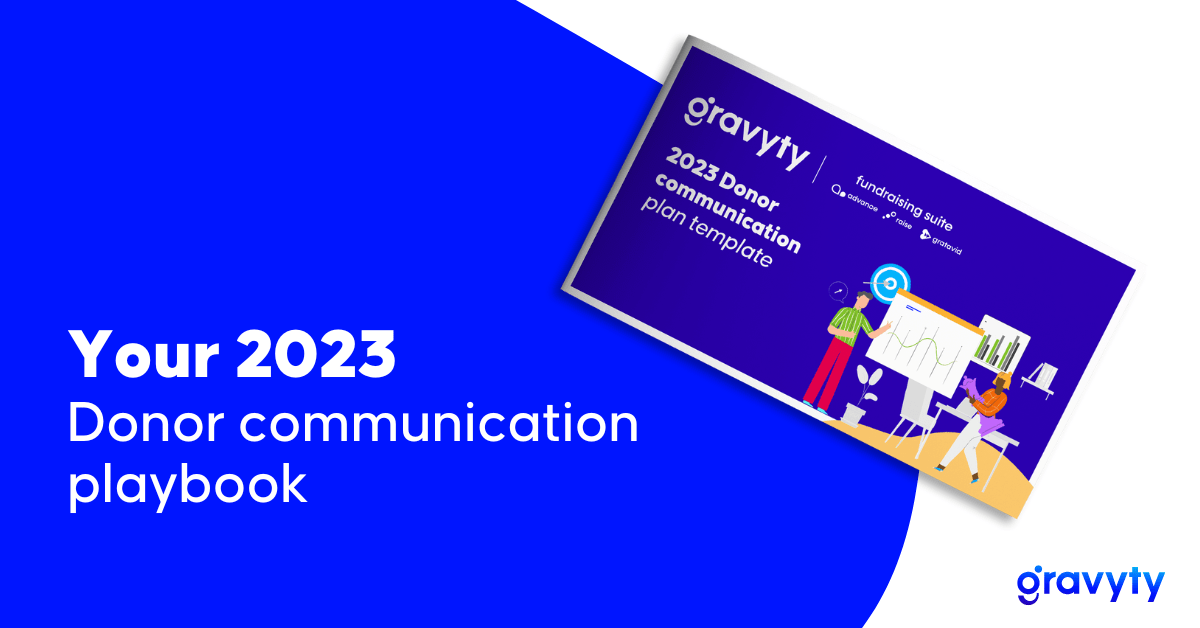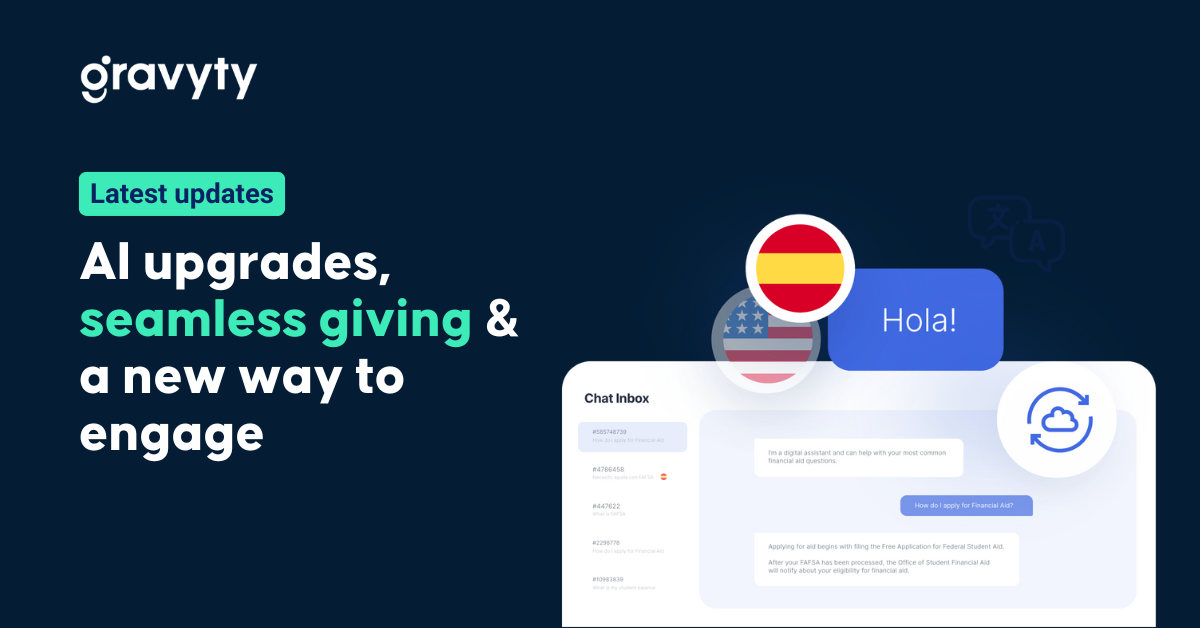Your 2023 donor communication playbook

Make each donor communication count
A successful fundraiser must be a “communicator extraordinaire,” keeping the flow of donor communications interesting and relevant to each donor’s interests while also reaching out only on their terms (yes, that means you can’t pick up the phone if a potential donor has indicated that they only want to be contacted by email).
Good donor communication is not only about only asking for donations (although this is certainly acceptable at certain times of the year) but also sharing news, sending personal greetings, and sharing impact stories that show how a donor’s contributions are having a positive impact. You also have to get the balance of communications right; bombard a donor with too many messages throughout the year and they may get annoyed and unsubscribe, but send them too few messages and you’ll be relegated to the recesses of their minds, never to be thought of again.
Why you need this donor communication plan template
Following a donor communications plan is a great way to ensure that your communications throughout the year remain varied and interesting. It also allows you to plan ahead and make sure you’re leaving enough time to communicate about any important events that are coming up.
When you have a monthly communications plan, you won’t accidentally let a month slip by without reaching out to your donor base. You can also get other stakeholders in your organization on board with your activities by sharing your fundraising communication plan at the beginning of the year so everyone is very clear about what’s coming up.
This donor communication plan template will accompany you throughout 2023 and ensure you always have the right thing to say to the right people and are never at a loss for words.
Donor communication plan by month
January
- Run a gratitude campaign—Thank your donors for their 2022 end-of-year gifts and show the impact achieved by their contribution. Instead of just writing a summary email, get creative by making a 2022 roundup video or getting some recipients of your initiatives to record personal testimonies and thank donors themselves.
- Make some personalized videos—Personal communications are the holy grail of donor stewardship, but there isn’t always enough time to call everyone up personally. Have an important member of your organization make a video thanking donors for all they have done this past year.
- Announce spring event dates—Share what’s going to be happening over the spring period so your avid followers are prepped and ready to get involved in your major giving events.
February
- Update your donors—There’s nothing worse than making a donation and never hearing back about how the project is progressing. Use the month of February to reach out to donors who gave gifts to specific projects and update them about what has been achieved and what still remains to be done.
- Skip the ask!—It can be tempting to throw in another little donor request at the end of your update email, but don’t! Build trust by sharing stories and reporting on activities without necessarily asking for anything in return.
- Tie-in with your social media—Most people are active on at least one or two social media channels—that includes your donors. For maximum impact, make sure the emails you’re sending tie in with what you’re putting out on your social channels.
March
- Generate a buzz around spring events—Whether you’re planning a spring Giving Day, crowdfunding campaign, or major donor dinner, now is the time to start generating some excitement around upcoming events. Let your community know how to get involved and ask them to invite others to join the cause. It’s also a great month to ask people to sign up for your recurring gifts scheme.
- Showcase success stories—Everyone loves a heartwarming success story. Keep engagement high by incorporating some major successes in your fundraising communications plan, e.g., the story of a graduating senior who was the recipient of a scholarship.
- Highlight a hero—Your volunteers work tirelessly without asking for a reward or thank you. Show your gratitude anyway by picking a volunteer (or volunteers) who have made a positive impact and feature them on social media and in an email campaign.
April
- Use segmentation to keep it personal—Don’t let up on donor stewardship; now is the time to thank those who participated in your spring campaign. Keep it relevant by segmenting your thank you messages. This means creating content tailored to those who donated at every gift level.
- Automation saves the day—Alleviate some of the burdens of trying to thank every single donor in the few days or weeks after a campaign by automating some email and video communications. This will allow fundraisers to show gratitude at scale, leaving them more time to build invaluable human-to-human connections as well.
May
- Give a heads-up for fall—You need a lot of time to build momentum around your fall campaign—share your fall plans and ask your donors to mark their calendars.
- Generate some summer fun—As the days get longer and brighter, people are anticipating the fun summer months. Give a heads up on your June, July and August plans—you can always send follow-ups and reminders again nearer the time.
June
- Consider a non-campaign ask—In the spirit of wanting to communicate with your people without always asking for something, your donor stewardship plan should include at least some non-ask requests. June is a great time to do this as there is no competition with your end-of-year events. Draw attention to a particular area of need and be very specific about what you are asking for.
- Highlight spring campaign impact—Share the impact of your spring campaign with donors. Use data and true facts as much as possible to verify your achievements.
July
- Launch the fall campaign—Go wild and start publicizing your fall campaign in all channels—including web, email, social, and video.
- Compare and contrast—People love to see progress, so comparison is a great tool. Show how this year’s campaigns have fared in relation to previous years. Of course, this works best if you zone in on the areas where there has been significant improvement over past years.
August
- Target major donors—Start upping your donor stewardship activities with major donors well in advance of year-end. Use highly personalized messages, emails and video communications to build relationships and make donors feel valued. If you have time for one-to-one interactions, then bring it on!
- Rally your troops—Reach out to some of the prominent people in your organization, asking them for their help and involvement. This can include well-known figures, board members, past presidents, revered volunteers, and anyone else who is in a position to make a big impact.
September
- Ready to “sprint?” —Map out your sprint timeline and messaging. You can already start creating the content and use automation tools to get the word out more efficiently.
- Map your donor journeys—Decide on the short-term communications journey you will take the donor through leading up to the campaign or event date.
October
- Follow-up—Prepare your post-campaign follow-up requests. Use segmentation and personalization as much as possible to enhance impact.
- Build your nurture cycles—If a gift was not made, decide what nurture cycle you will launch to try and entice donors back to the fold. Keep your eye on the end of the year and send out a sequence of nurturing communications well in advance of your year end campaign.
November
- Giving Tuesday (November 28, 2023)—Generate a buzz about your Giving Tuesday campaign throughout this month. Use an automated platform like Advance from Gravyty to run an exciting and dynamic event.
- Set up meetings—Start setting up some Q1 meetings. You’ll need to give your donors plenty of notice and also need to leave yourself time to make any necessary travel arrangements.
- Plant the seeds for 2024—Whatever you’ve got in store for 2024, now is the time to start planting the seeds. Mention important initiatives you hope to raise money for or start talking about an upcoming event.
- Focus on small and mid-level donors—Begin end-of-year communications for small and mid-level donors. Use video to make things more personal and allow donors to put a face to your name.
December
- Make it personal—You’re not the only one bombarding your donors with philanthropic materials at this time of year. Cut through the noise by upping the personalization so your donors know that you really see “them.”
- Round-up time —That satisfying feeling of knowing that the year’s work is done! Compile 2023’s updates and impact stories in an impact report to send to donors. An accompanying video will help get your messages across, especially to those who won’t read the report!
Build your donor communication plan
You’ve started to plan your 2023 donor communication strategy. Now it’s up to you to consider your needs and determine what you need in your fundraising toolkit to bring your plan to life.
Gravyty’s fundraising suite of solutions allow you to personally and meaningfully connect with your donors and prospects at the right time, helping you build stronger and longer lasting relationships.
Learn how Gravyty’s fundraising suite can help you engage, ask and thank your network to power your cause. Let’s talk.



